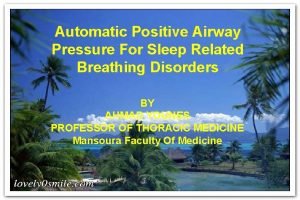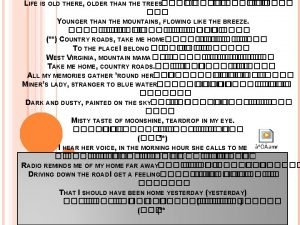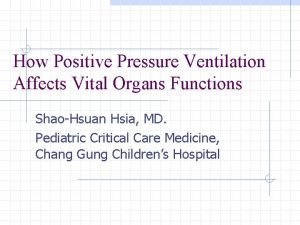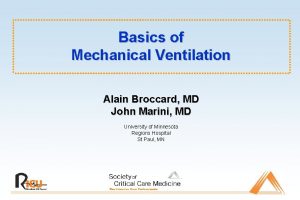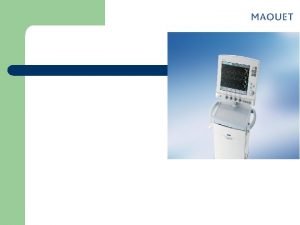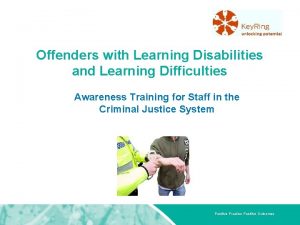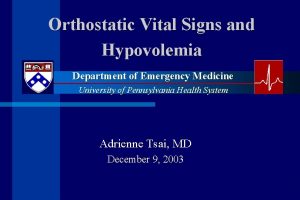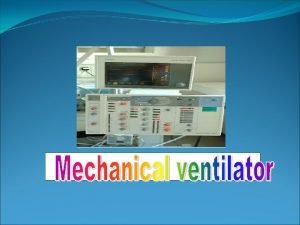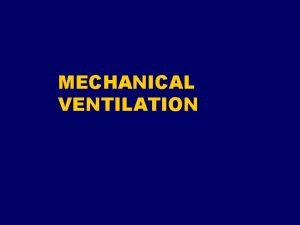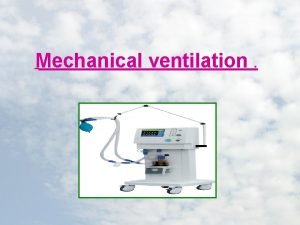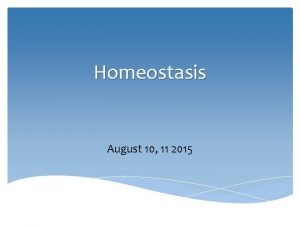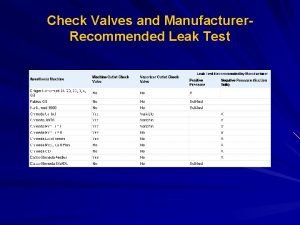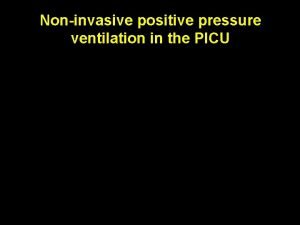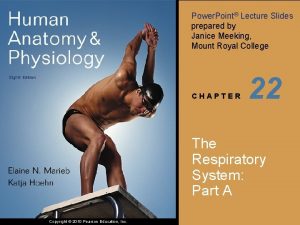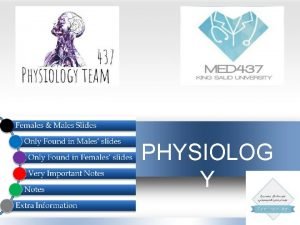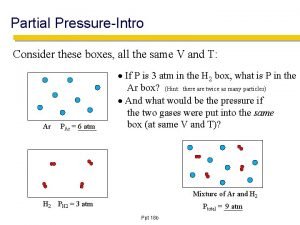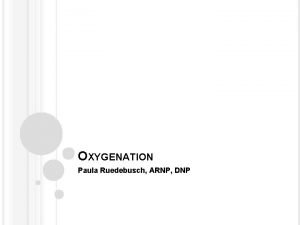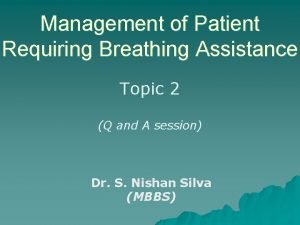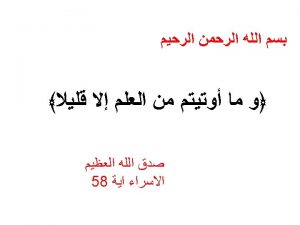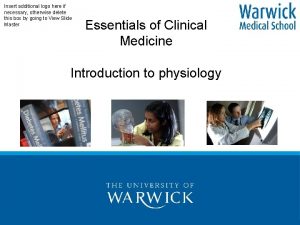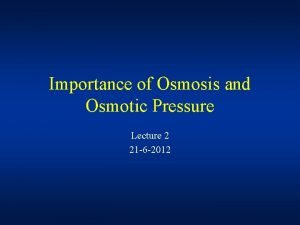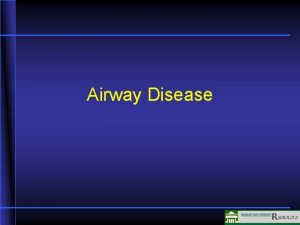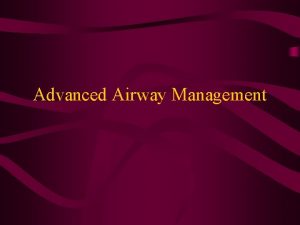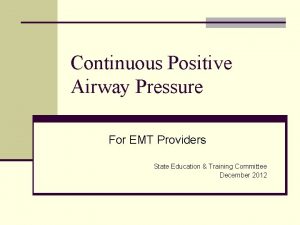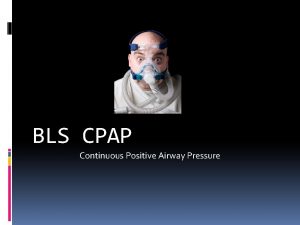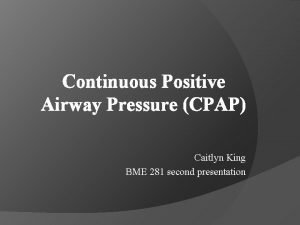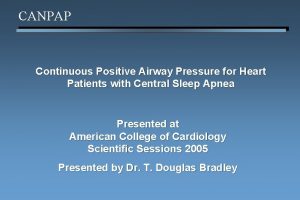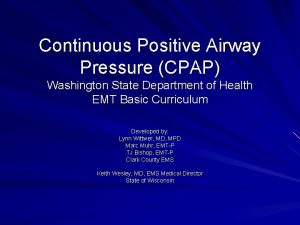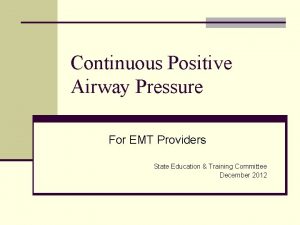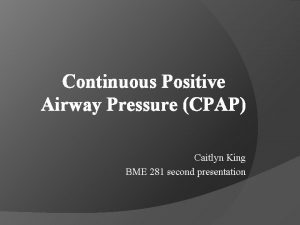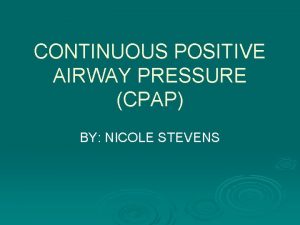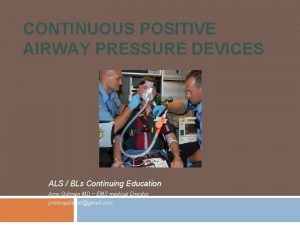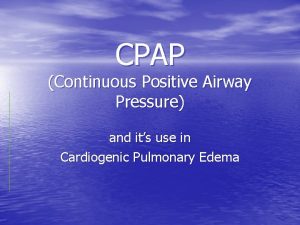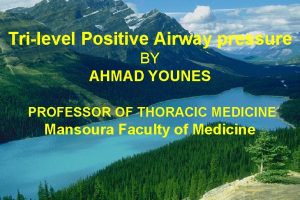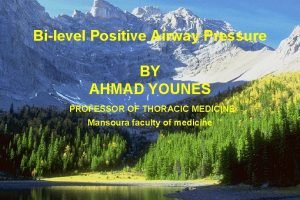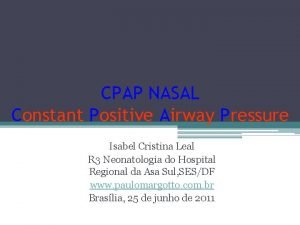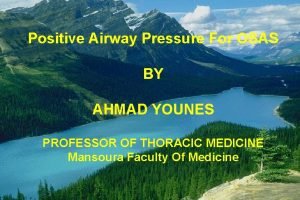Continuous positive airway pressure in older people with

































- Slides: 33

Continuous positive airway pressure in older people with obstructive sleep apnoea syndrome (PREDICT): a 12 -month, multicentre, randomised trial 組別: 第 6組 指導老師: 李毓森 老師 組員: 王建勛CPT 1020035 吳昇翰CPT 1020037 沈嘉鴻CPT 1020048 何冠志CPT 1020051 姜澤民CPT 1020052 報告日期: 12/29 1

OUTLINE Introduction ¡ Methods ¡ Results ¡ Discussion ¡ 2

Introduction ¡ Obstructive sleep apnoea (OSA) l l One of the commonest respiratory disorders affecting Up to 20% of the general population ¡ OSA syndrome of affect: 4% of the middle-aged population (30– 60 years) ¡ With the current obesity epidemic ¡ CPAP therapy is an efficacious and costeffective treatment for middleaged patients with moderate to severe OSA syndrome. 3

¡ Reversing the OSA syndrome 1. 2. Any functional impairment could increase independence Reduce health-care costs in ageing populations ¡ The magnitude of the treatment and economic benefits of CPAP shown in middle-aged people cannot be extrapolated to older populations. ¡ This trial was designed to assess the efficacy of CPAP to reduce daytime sleepiness in older people with OSA syndrome and to determine its costeffectiveness. 4

The long-term consequences of OSA syndrome 1. 2. 3. 4. 5. 6. 7. social functioning quality of life neurocognitive impairment increased risk of road traffic accidents Cerebrovascular & Cardiovascular metabolic morbidity higher mortality 5

Methods ¡ The PREDICT trial was a multicentre, investigatormasked, randomised, parallel controlled trial done in 14 National Health Service (NHS) sleep centres in the UK. 6

¡ ¡ A diagnosis of OSA syndrome was based on the clinical practice in each centre Criteria: l l Fulfilled for a diagnosis were 4% or greater oxygen desaturation index (ODI) with more than 7· 5 events per h Epworth sleepiness score (ESS) of 9 or greater 7

Exclusion criteria 1. 2. 3. 4. 5. Previous exposure to CPAP Awake oxygen saturation (Sp. O 2) <90% Ratio of forced expiratory volume in 1 s to forced vital capacity <60% Being a professional driver Reporting sleepiness while driving, shift work, or any severe symptom of OSA syndrome for which the referring physician felt CPAP was mandatory 8

Randomisation and masking ¡ Patients were randomly assigned (1: 1) centrally by MRC CTU by computer-generated randomisation 1. 2. ¡ Minimisation by ESS at enrolment (>13 vs ≤ 13) Functionality (Townsend Disability Scale [TDS] >1 vs ≤ 1), and recruitment centre The allocation group was revealed by telephone to the (unmasked) investigator initiating the intervention, once baseline data collection was complete. 9

Procedures ¡ BSC was comprised of advice on minimising daytime sleepiness through: 1. 2. 3. 4. sleep hygiene naps caffeine weight loss As appropriate to each patient ¡ Both groups had identical visit schedules, and were asked to continue with their usual drugs and medical care during the trial. 10

¡ All patients received a telephone call at 1 week, 1 month, and 6 months to record symptoms and side-effects and to optimise CPAP adherence. ¡ Patients also completed monthly diaries 1. 2. 3. 4. 5. 6. recording symptoms side-effects use of health care change in medication functionality and quality-of-life questionnaires 11

¡ All enrolled patients completed a domiciliary overnight respiratory polygraphy study (Embletta Gold, Embla, Amsterdam, Netherlands) before initiation of CPAP, the results of which were scored centrally. ¡ Domiciliary overnight pulse-oximetry (Konica -Minolta, Osaka, Japan) was done at 3 months and 12 months. 12


Outcomes ¡ Coprimary outcomes l subjective sleepiness at 3 months measured by the ESS l cost-effectiveness of provision of CPAP over the 12 months measured by quality-adjusted life-years (QALYs) calculated with the European Quality of Life-5 Dimensions (EQ-5 D) l use of health-care resources, which was collected monthly from patient diaries. 14

¡ Secondary outcomes l l l l subjective sleepiness at 12 months objective sleepiness(Oxford Sleep Resistance test [OSLER]) quality of life (Short-Form 36 [SF-36]) Sleep Apnea Quality of Life Index (SAQLI) mood (Hospital Anxiety and Depression Scale) functionality (TDS) nocturia mobility (Timed Up and Go test) 15

¡ Secondary outcomes l l accidents (domestic and driving) cognitive function (Mini Mental State Examination) cardiovascular risk factors cardiovascular events at 3 months and 12 months 16

Statistical analysis ¡ ¡ The study was designed to detect a minimally clinically important change of one point in the ESS Analysis was by intention-to-treat with adjustment for treatment allocation, minimisation factors, and the corresponding baseline variable of the outcome. 17


¡ The average QALYs with the EQ-5 D l CPAP were 0・ 68 (95% CI 0・ 64 to 0・ 72) l BSC were 0・ 67 (0・ 63 to 0・ 71) 19


¡ ¡ Objective sleepiness was significantly reduced at 3 months , but less so at 12 months Change in ESS and change in OSLER time were significantly correlated at 3 months (– 0・ 22; p=0・ 0008) and 12 months (– 0・ 17; p=0・ 010). 21


¡ Mood, functionality, nocturia, accidents, and cognitive function unchanged 23

¡ ¡ ¡ At 3 months, CPAP reduced TC and LDL , but the effect was not sustained at 12 months. SBP was improved at 12 months, because of a decrease in SBP in the BSC group. The incidence of new cardiovascular events did not differ between groups at 3 months or 12 months. 24

¡ ¡ 140 patients randomly assigned to CPAP, self -reported they were still using CPAP. l 120 (86%) at 3 months l 99 (71%) at 12 months Usage data for CPAP were obtained l l 117 patients at 3 months with a median usage of 1 h 52 min per night 102 patients at 12 months with a median usage of 2 h 22 min per night. 25

Discussion ¡ This 12 -month randomised controlled trial has unequivocally shown that l ¡ CPAP reduced subjective sleepiness in older people with OSA syndrome at 3 months, despite low overall CPAP usage. The reduction in subjective sleepiness was corroborated by a significant improvement in objective sleepiness, measured by the OSLER test at 3 months. 26

¡ CPAP also produced significantly better quality-of-life outcomes 1. 2. SAQLI SF-36. 27

¡ Secondary outcomes related did not show any difference between the two groups 1. 2. cognitive function mood affect cognitive function 28

¡ ¡ The mean usage of CPAP was similar to a 6 month, randomised, controlled trial of CPAP in minimally symptomatic patients with OSA Could have contributed to lower CPAP adherence, because 50% of the patients in our trial reported sleeping alone l adherence to auto-titrating and fixed CPAP has not been shown to differ 29

¡ ¡ ¡ The effect of CPAP on ESS in middle-aged patients with mild OSA has been reported as – 1・ 07 (SD 2・ 4) PREDICT for a one point change in ESS and quality of life at 3 months and 12 months might go some way to support the notion that changes of this magnitude in ESS are clinically meaningful in this age group 30

l Additionally, to our knowledge, PREDICT is one of the first trials specifically aimed at older people (≥ 65 years) l The mean age of 70 years, with no participants younger than 65 years, 31

¡ ¡ ¡ The PREDICT trial has also been one of the longest, randomised, trials of CPAP treatment for OSA syndrome, directly measuring both therapeutic and economic benefits. polysomnography is not routinely done for the diagnosis of OSA syndrome Use of polysomnography would have been financially and practically prohibitive. 32

¡ ¡ The older patients slept poorly ODI↓ CPAP treatment reduces symptoms of excessive daytime sleepiness We recommend that CPAP treatment should be offered routinely to older patients with OSA syndrom Especially those with higher ESS and future research should focus on how best to optimize CPAP delivery in this age group. 33
 Ahi cpap
Ahi cpap Epiglottic
Epiglottic Life is older than the trees
Life is older than the trees Optimal peep
Optimal peep Mean airway pressure
Mean airway pressure Mean airway pressure formula
Mean airway pressure formula Airway pressure release ventilation
Airway pressure release ventilation As people grow older
As people grow older Past continuous for future
Past continuous for future Present simple past simple future simple
Present simple past simple future simple Gram positive catalase positive cocci
Gram positive catalase positive cocci Positive + positive equals
Positive + positive equals Positive practice positive outcomes
Positive practice positive outcomes Orthostatic vitals definition
Orthostatic vitals definition Mechanical ventilator modes
Mechanical ventilator modes Positive end expiratory pressure
Positive end expiratory pressure Positive end expiratory pressure
Positive end expiratory pressure Mechanical ventilation indications
Mechanical ventilation indications Positive feedback blood pressure
Positive feedback blood pressure Low pressure leak test
Low pressure leak test Positive pressure pc case
Positive pressure pc case Elmslie trillat
Elmslie trillat Pressure support vs pressure control
Pressure support vs pressure control Continuous bedside pressure mapping
Continuous bedside pressure mapping Intrapulmonary pressure vs intrapleural pressure
Intrapulmonary pressure vs intrapleural pressure Starling
Starling Partial pressure
Partial pressure Intrapleural pressure
Intrapleural pressure Confining pressure vs directed pressure
Confining pressure vs directed pressure Sore throat after surgery
Sore throat after surgery Static pressure and dynamic pressure
Static pressure and dynamic pressure Oncotic pressure vs hydrostatic pressure
Oncotic pressure vs hydrostatic pressure Hydrostatic pressure vs colloid osmotic pressure
Hydrostatic pressure vs colloid osmotic pressure Hydrostatic pressure vs osmotic pressure
Hydrostatic pressure vs osmotic pressure
